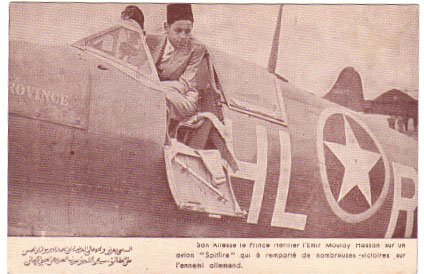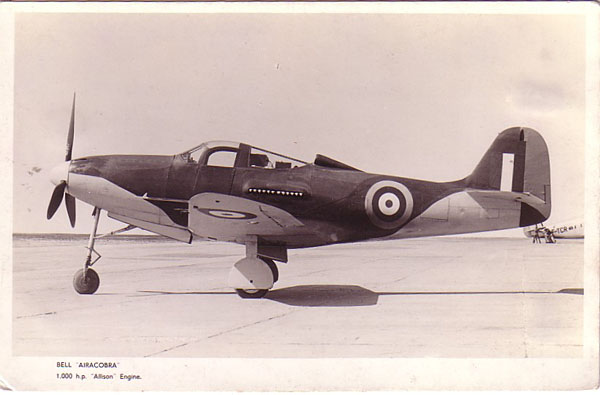
|
NEWSLETTER #65 - DECEMBER 2008 WORTH A SECOND GLANCE
WWII CONNECTIONS
Although the bulk of WW2 postcards are the mass produced recognition and/or propaganda cards, occasionally one surfaces which features a lesser known aspect of operations. One such is this card, produced in French North Africa and titled in French & Arabic "His Highness the Crown prince Emir Moulay Hassan in a Spitfire aeroplane which has achieved many victories over the German enemy".

The said Crown Prince would later become King Hassan of an independent Morocco. He was born in 1929, so about 14 at the time of the card, ascended the throne as Hassan II in 1961 and was the longest serving Arab head of state at his death in 1999, having survived a number of coups and assassination attempts. The card is presumably part of propaganda for the return of French rule after the North African invasion of November 1942, the first major deployment of US forces against Germany. There is unlikely to be another contemporary card to show a Spitfire in USAAF markings. This one carries the squadron code HL-R and a name which ends in "rovince". A B-17 tail is in the background. From the HL code can be determined the squadron, 308th Fighter, of 31st Fighter Group. This squadron retained Spitfires into the Italian campaign , which it initially supported from a hurridly completed airstrip on the maltese island of Gozo. At the end of the war, the 31st Group, including the 308th had operated from 22 different bases and was credited with 570 kills. The reason why the 308th had Spitfires at all provides a link to another card. The 308th was formed in Jan 1942 and was originally to be equipped with the Bell P-39 Airacobra. However, concerns about the suitability of the P-39 led to the squadron embarking for Europe without its aircraft and being converted to a Spitfire squadron at Atcham, near Shrewsbury. The Spitfires were not replaced until April 1944 when P-51 Mustangs took over. The P-39 was an unorthodox fighter, it was powered by an in-line Allison engine buried in the fuselage, driving the propellor through a long shaft passing under the cockpit. It was also unusual in having a tricycle undercarriage. Both of these factors added complexity and another negative was the inadequate turbocharger which inhibited operations at altitude. On the plus side it had heavy protective armour and a high calibre 37mm cannon firing through the propellor hub. Indeed the whole design, including the mid-engine had been built around this armament. One squadron was delivered the the RAF, who declared it unsuitable due to low rate of climb and poor performance at altitude. This card shows one pre-delivery, somewhere in Canada – TCA Lockhed 14 CF-TCR in the background. Anonymous publisher but style similar to Flight magazine.

Despite its shortcomings, almost 10,000 were built and usage was split 50:50 between the USAAF in the Pacific and supplied to Russia. On the face of it the Airacobra is the antithisis of what was required in a Soviet fighter i.e Can operate from a snow covered ploughed field and can be maintained by a tractor mechanic. But it did have heavy weaponry and protective armour so was suitable for the low level support operations of the Eastern front. One Russian ace recorded the highest number of “kills” in a US built aircraft in all theatres of WW2. The Russian aircraft were delivered by air, flying up to Alaska, then over the Bering Strait and across Siberia. Not all made it and, in recent years, a number of wrecks have been recovered from along the route. For lots more on Russian P-39s and wreck recoveries see http://lend-lease.airforce.ru/english/index.htm
|